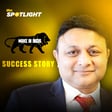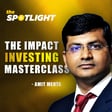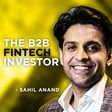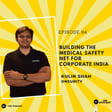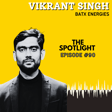Become a Creator today!Start creating today - Share your story with the world!
Start for free
00:00:00
00:00:01

Building The Full Stack For Green Appliances | Omer Basith @ Virtual Forest
Virtual Forest is a startup helping appliance companies build more energy-efficient products. Omer has had a fascinating journey- from first running a family business to now building a funded technology design startup. He talks about the impact that is possible just by adopting superior motor technology in products like air conditioners, fans, washing machines and Electric Vehicles.
What you must not miss:-
- Founding thesis
- Reasons for having co-founder
- Carbon capture technology
- Models of manufacturing
Transcript
Introduction and Background
00:00:00
Speaker
Hi everyone, I'm Omar Basun. I'm the CEO of Virtual Forest and I'm really happy to be here.
00:00:17
Speaker
There was a time when the world thought that poverty reduction would only happen through government intervention. But we have now seen how the free market system lifts up the wealth levels of entire nations and builds a robust middle class. Similarly, it is the work of innovative start-ups more than government intervention that is actually making an impact at scale in the fight to reduce our collective carbon footprint.
Journey and Challenges
00:00:40
Speaker
In this episode, your host Akshay Dutt talks with Omer Basit, the founder of Virtual Forest, which is a startup helping appliances companies to build more energy-efficient products. Omer has had a fascinating journey from first running a family business to now building a funded technology design startup.
00:00:57
Speaker
In this conversation, he talks about the impact that is possibly just by adopting superior motor technology in products like air conditioners, fans, washing machines, and electric vehicles. Stay tuned for the conversation and subscribe to the Founder Thesis Podcast on any audio streaming app to learn about how startups are helping save the environment while building a sustainable business.
00:01:25
Speaker
I'm from Bangalore. My grandfather started life as a goat herder, I'm told. He started buying goats somewhere outside Bangalore and then herding them and bringing them to Bangalore and selling them at a higher price. He somehow learned how to make ink and also managed to get a contract to supply ink to the government during World War II.
00:01:49
Speaker
And in a lifetime, he went on to set up what was a huge soap making factory in Bangalore called DC Soapworks that made sandalwood soap. And from what I'm told was extremely successful and wealthy and also in a lifetime lost it all. Yeah. So apparently there was a ban on something called tallow, which is one of the main things that they used to make soap. And that's like animal fat.
00:02:12
Speaker
Yeah, so that meant that his business fell apart. So my father borrowed a little bit of money from my grandfather. I think he made him sell his car and this was when they had nothing to start an electronics company. They set up a company to start supplying capacitors to ITI, the telephone industry.
00:02:32
Speaker
So they set up a company. My mother and my father set up a company and they started doing business with the government entity. Unfortunately, when I was six, my father passed away. And so then my mother was forced to take over the company and run it. And as you can imagine, I'm talking about 1986, it was very difficult for a woman to run an electronics company.
00:02:52
Speaker
And at its peak, it was going 350 plus and stuff like that. And my uncle and my mother ran this company for many years. And then after that, I came and joined this company for a couple of years and I left and did my own thing.
Focus on Energy Efficiency
00:03:08
Speaker
I worked in every single domain that you can think of. I've worked in hospitality. I've worked in media. I have worked in logistics and then a couple of different industries like that. But eventually after working a few years in that company, I went and did my own
00:03:21
Speaker
for several years and then came back, worked for a few more years and then sold that company. I exited that company, I'm going to say about five years ago now. Did you get like a reasonable amount of cash on selling it or was it just sold for parts? Sold for parts. Okay. So then tell me that process of that decision-making process of deciding what you want to do next.
00:03:43
Speaker
When all of this was happening, you know, I just had children. My children were very young at the time and it became clear to me that with the finite amount of time that I have left in my career and possibly on the surf, I wanted to do something that would be a little bit more relevant and certainly would be able to do something towards combating climate change. I personally believe that's the priority for certainly my lifetime and possibly for the next century.
00:04:08
Speaker
So there was an opportunity here to go after the application that I knew very intimately that was motor run applications. Motors consume about 65% of residential energy in your typical home. That's with your fans, AC, refrigerator, washing machine.
00:04:25
Speaker
and whatever other application that you might have. The technology which I was working on was for induction motors. These motors typically are 65 to 70% efficiency and absolutely high efficiency motors are a little bit higher than that. The newer technology, which is BLDC and other motor types like VMSM are 80% plus. So by shifting over to these motors, you're seeing a certain efficiency improvement and this consequently leads to more energy efficiency.
00:04:55
Speaker
But apart from that, these motors also can be controlled with high resolution speed control. So you can speed up and slow down or do whatever you want with these motors where you would need a gearbox otherwise to change the speed of the open induction motor. So that's the technology that I started working on. This is a domain called motor control.
Motor Technology: BLDC vs Induction
00:05:15
Speaker
I want to zoom in on this induction versus BLDC. What is an induction motor and how is BLDC different at a fundamental level? Induction motor technology is something that's been in place for over a hundred years and maybe even more than that, I'm not entirely sure. And this is a robust design that's easy to control and doesn't need specialist electronics that can be started on control using.
00:05:38
Speaker
electromechanical control. So induction motor is a stator with copper windings that operate as a rotor and that causes the motor to move. So electricity does some magnetization which causes the circular motion. Yeah, so the current passes through the copper windings which causes a magnetic flux which makes the rotor move around.
00:05:59
Speaker
And why is it only 60% efficient? Where is the remaining 40% good? That's like heat waste or something like that? Yeah, induction motors are prone to heat up. There is certainly loss of power for heat, loss of power for sound, then the noisier than the LGC motors as well. Okay, so that's induction. Got it. Okay.
00:06:19
Speaker
Now, what is BLDC? BLDC stands for brushless DC motors. Okay. And so these are permanent magnet motors. So the magnetic flux is created using a permanent magnet. These are more efficient, less noisy, less prone to the heat and also have a longer life because of less wear and tear.
00:06:38
Speaker
Why is it called brushless? What is the significance of the word brush here? Should DC motors otherwise use a brush to connect the rotor to the stator? Whereas in this case, that is not the case. So induction is AC and BLDC is DC. In a manner of speaking, a three-phase induction motor also operates in a similar sort of method to a BLDC motor. And the same sort of motor control electronics can be used for a three-phase induction motor and BLDC motor as well.
00:07:06
Speaker
In a BLDC, there's no loss due to heating and sound and all that. There is, but less. No machine is perfect. So there will be losses for the same reasons, but less considerably less compared to an induction motor. Induction motors have a very, very high starting cut.
00:07:23
Speaker
To get an induction motor to start rotating, it requires sometimes twice as much of its normal operating current. And that's again a huge challenge because that puts a lot of strain, a lot of starting inductive load on the grid and imagine everyone started it.
00:07:38
Speaker
But in case of BLDC, because it's permanently magnetized, it's using some permanent magnet. So therefore, it doesn't need so much starting. Yeah, it doesn't. It's a gradual starting cycle. And again, it's controlled by electronics, by motor controllers. So you can have what's called a soft start or a gradual ramp up rather than what happens in the case of an induction motor.
00:08:00
Speaker
The other thing is that an induction motor runs at one speed. It turns on, it runs at full speed. It turns off and it stops. These are the only two operating modes. To change the speed, you need gears. That's the only way to change the speed. You need gears. There are also methods to change the speed using voltage, but then that makes the motor considerably more inefficient.
00:08:22
Speaker
So that's what happens in the case of your ceiling fan with your wall regulator. You're changing the fan speed by reducing the voltage which reaches the motor. However, at lower speeds, the fan is extremely inefficient. And this voltage regulation is where a capacitor comes in? Yeah, in the case of a wall regulator, yes, it is capacitors that are used to do this.
00:08:46
Speaker
Well, I remember as a kid when the fan would slow down, the electrician would say, capacitor, but that's not for the voltage regulation. So that's a motor run capacitor. I'll try to explain what happened. So now when you're using AC current, when the current is in the positive cycle, the motor runs 50% of the overall 180 degrees.
00:09:06
Speaker
However, when it goes into the negative cycle, the capacitor discharges into the winding, hence giving it enough power to complete the rotation. So that's what a long capacitor does. That incidentally is the type of capacitor that my older company used to produce. But in case of a BDC, you're saying that you can change the speed of the motor without that wastefulness which is caused by voltage control.
00:09:29
Speaker
Absolutely. Yeah. So that's how it is in the case of BLDC. But the challenge with BLDC is you require motor control electronics, which add cost to the overall product, but overall really improves the functionality. You can have very high resolution speed control, like just one or two RPM even. And now you can use this functionality to help save energy as well.
00:09:51
Speaker
So motors follow something called the affinity laws. So the affinity laws define the relationship between motor speed and power consumed. So there's a cubic relation. Say a 10% speed reduction in the motor can be a 35% power reduction. So this is why it's important to be able to control the speed.
00:10:12
Speaker
Now in the case of a normal air conditioning, in the case of a normal air conditioner, you switch on a fixed speed air conditioner, you turn on your air conditioner, it runs at full speed. When it thinks it's reached a temperature, it cuts off. And then it starts again after the temperature increases by whatever threshold that that's required.
00:10:29
Speaker
That isn't the case of an inverted air conditioner. It gradually speeds up, reaches the temperature you want to reach, and then it slows down slightly without going off. And the temperature is then modulated very effectively to make sure that you're using as little energy as possible.
00:10:46
Speaker
So the combination of the more efficient BLDC motor along with speed control algorithms that are in place in these appliances in the case of air conditioning mean as much as 30 to 35% energy saving when compared to a normal air conditioner.
00:11:02
Speaker
You don't have a cold start energy loss, which would happen in an induction motor. You don't have that starting load, plus also the speed control that's in place helps reduce the overall energy consumption as well. So there's a very real energy saving that's happening over here. And the case of an application like ceiling fans, there's literally a 50% energy saving between a normal ceiling fan and a BLDC ceiling fan. And that's very significant. That's a very significant. That's a real focus area for us.
00:11:31
Speaker
Like the energy ratings. So if an AC has a high star rating, that probably means that it's because of the BNDC voters or that could be a major contributor. Oh yeah. So look, India has been on its energy efficiency journey now for specifically for air conditioning from, I'm going to say 2011, maybe, and we leave the standard and labeling program
00:11:53
Speaker
That's the BE star rating methodology is possibly the world's largest energy efficiency program and certainly one of the most effective. The way it works is this is something that most consumers aren't aware of, rightly so, is that the star rating system for air conditioners, when it was defined
00:12:11
Speaker
A five-star rated air conditioner at that time can no longer be sold in India. So, every two years, the star rating system is revised. So, a five-star rated unit right now in two years time becomes four-star and so on and so forth. Constantly on this journey to be more and more efficient.
Energy Efficiency Standards and Virtual Forest's Mission
00:12:29
Speaker
And it's interesting that this is not something that the end consumer is particularly concerned about because they're not going to, and they shouldn't be liable to pay more for an appliance saying that, okay, the star rating is revised. It's up to manufacturers and companies like us to innovate and make sure that these products get more and more efficient and cost the same. So that's the challenge, the opportunity and every challenge is an opportunity.
00:12:53
Speaker
What you wanted to do was make these motors, the BLDC motors, as a way to reduce energy inefficiency. So we make the controllers for this. When we looked at this industry, that was really the gap. India has a pretty good motor manufacturing ecosystem in place. And the motor manufacturers, while they were mostly making induction motors, have already been able to make that shift from induction to BLDC quite effectively. It was a nice
00:13:17
Speaker
massive concern whether the Indian motor manufacturing ecosystem would be able to catch up. But you know what, it's happened rather easily in my opinion compared to what people expect. Who are the biggies in motor manufacturing? So of course, different applications have different players. So in the home appliance space, there's a company called PICL, which makes motors for air conditioning.
00:13:37
Speaker
outdoor units and indoor units. There's a company called SCPL against Swaminathan Enterprises. And of course you have the fan companies. The fan companies make 40 million motors a year in India. And they're all the kromptons of the world, the hadders of the world. And interestingly, a company that I have so much admiration for, this conglomerate called Yush fans, I think they might make around 30% of the fans that I use there. Maybe more than that, used in India, just one company to end, of course, they make and brand and sell
00:14:07
Speaker
So these applications are extremely material in terms of our overall energy mix. So currently 25% of domestic energy usage in India is from ceiling fans and only about 13% is from air conditioning.
00:14:28
Speaker
But come 2030, with the forecasted penetration of air conditioners in Indian homes, that energy makes you move to a 30% energy consumption by air conditioning. And I think ceiling fans fall to around 15% or 16%. So as you can see, this is very significant.
00:14:43
Speaker
At this moment, 25% of residential energy consumption from ceiling fans is equal to 6% of India's total energy consumption. That's a huge amount. So imagine if we were able to replace all the ceiling fans with BLDC ceiling fans, that 6% would become 3%. Imagine this is such a low cost and such a low friction way to save 3% of India's total energy consumption. It's ridiculous. So there's that.
00:15:13
Speaker
And as the penetration of air conditioning increases, I think India has about an 8% residential air conditioning penetration. Of course, that depends on who you ask. It's between 5% to 8%. And this will be about 30% by 2030.
00:15:29
Speaker
Yeah, growing incomes, like the first thing you do as your income increases by an AC. Growing incomes, but also it's going to be a point where it's going to become imperative for human comfort, for people to use air conditioning, especially in these extreme summers that we're already experiencing, and it's going to be getting considerably worse in the decades to come. So that's how we're going after them.
00:15:50
Speaker
So you said with co-founders, tell me about that. Like, why did you want to have co-founders? My co-founders are also like the custodians of our technology. So they're the technology guys, right? I don't even pretend to be a technology guy anymore. You know, the story of me and my co-founders is a pretty interesting one as well. When I was a part of the previous company that I worked with, I was exploring the range expansions, product expansions as much as I could. So looking for opportunities in other industries.
00:16:18
Speaker
And at the time I met with my co-founders, what started a company called TCPL, Think Circuit Technologies at the time. And they were doing some work for the Indian Railways and for defense like DEL, et cetera. I, in my personal capacity, invested some amount in that company and, and also jointly invested in the development of a technology for the Indian Railways. So we worked really hard on, on trying to develop what was called a CCB computer control breaking
00:16:48
Speaker
But we were successful in creating the technology, but I would say very unsuccessful in navigating what it takes to do business in the Indian railways. So ridiculous that the way it works is there's an organization called the RDSO, which uploads specifications for a particular product. And once the specification is uploaded, you can develop and bid for that particular product.
00:17:10
Speaker
particular project. So for this particular project, it was called the indigenous computer controlled breaking system. They had created the entry on their website, but didn't upload the specifications over four years. It was just waste. Eventually after having worked with these guys for a long time and after having invested a fair amount of money in this project, it was ultimately a failure.
00:17:32
Speaker
And you would think that at that point, people wouldn't want to see each other again, having people do with each other. But I kept in touch with these guys because I believed that they were great technology partners to have. And after I exited Solid State Systems, that's my previous company, reached out to them and we set up virtual forests and virtual forests then absorbed think circuit technologies, which was their company.
00:17:52
Speaker
So like what was the segment that you wanted to make these controllers or was it for fans or like what kind of... Okay, so I'll start off by first of all describing the story behind the name of our company. So our company is called Virtual Forest Private Limited. Just like how trees sequester carbon emissions from the atmosphere, our products mitigate carbon emissions from entering the atmosphere.
00:18:15
Speaker
It's our objective to get as many of our products out there. It's equal to planting trees and heads and making a virtual forest. So that's why we're called virtual forest. Now, our objective is we create motor control solutions for the journey to net zero. And then we've identified a couple of technology pathways.
00:18:33
Speaker
is to have reached that. The first one is energy efficiency. And we started doing work in energy efficiency and specifically in home appliances because this was a segment that had an existing market at the time. We identified air conditioning as the first place that we would do work. And the reason for this was because when we started three years ago, air conditioning, invert air conditioning has already made up around 50% of the overall annual
00:18:57
Speaker
So there was an existing market and the opportunity to start generating revenue as early as possible, although it did take longer than expected. And then that's where we started work. Of course, the downside of that is you're seeking an import substitution opportunity, which means that you're operating in a space that already has a lot of competition. But that's where we started. And then from there, we've gone on to
00:19:19
Speaker
create solutions for BLDC ceiling fans. And both of these products are now in mass manufacturing. And from Q4 of last year up to now, we've been supplying several hundred thousand pieces of these into the market. And so now this business has started growing at a good rate.
00:19:34
Speaker
The good thing is that after having established a bit of a track record, after having had a success in this particular segment, we're really starting to see network effects now. So first of all, we are getting a lot of repeat business from our existing customers for other appliance requirements, but also you're slowly gaining some kind of leadership position as far as
00:19:55
Speaker
motor control is concerned at the moment that we get a lot of adjacent projects as well in other applications. And now in customer validation, we have a couple of couple of key new products, which will be entering production this year as well. So we have a solution for solar pumping, which again is a huge, huge application for, and for emissions reductions. And, and that's, and also we have a product for inverter washing machines, which we're going to production this year. And.
00:20:22
Speaker
and also other small home appliances like mixer grinders and stuff like that. So all of these are BLDC motor controllers for these applications. So they make them much more efficient, but also add a whole lot of new functionality and reliability to these applications. So that's one of the major technology pathways.
00:20:38
Speaker
Pre-virtual forests, the controllers were being imported from China. Yeah, 100%. The vast majority of controllers are still imported. That's another major theme is the fact that we're really trying to make sure that certain applications like air conditioning where there's going to be so much aggregated demand over the next decade or so.
00:20:59
Speaker
It's important to make sure as much of the value addition for this demand which is generated in our country stays within our borders and so that's a major objective for us as well and that's why we're trying to really help substitute products which were otherwise poorly imported from China and other countries.
00:21:16
Speaker
So that's how it is. So the technology pathway of energy efficiency is something we need to do work in. While we're doing a lot of work in home appliances right now, we will also be focusing on industrial applications for the latter half
R&D and Industrial Applications
00:21:29
Speaker
of this decade. We are already doing some minor projects for certain niche applications, but we think industrial use cases will be big for our energy efficiency technology pathway.
00:21:39
Speaker
I'll give you a description of the kind of niche areas that we've already signed to do some work. So there's a company that makes coolants for CNC machines, coolant pumps for CNC machines. So currently they have five or six different models of pumps, which have different flow rates and work for different sorts of coolants.
00:21:58
Speaker
By using our technology, by using our controllers, they're able to standardize one pump, which is much smaller than all the different pumps that they have right now. And they can control the speed of that pump, the flow rate, the sort of torque required using our controllers. That's a big sort of advantage for them. That's the example of the industrial applications that we'd be going after. And we go from there and we see what else we can do.
00:22:21
Speaker
The second technology pathway is e-mobility. That's a segment that we started doing work in, I'm going to say about August of 2021. We started engaging with OEMs as well as tier one companies of this particular space. And since then we have first of all done understood the requirements of this done a whole lot of R&D and in the various sort of controllers that are relevant for our market at this juncture.
00:22:47
Speaker
and have developed products towards the same. Currently, in validation, we have a controller for low-speed two-wheelers, which will be going into production in the next quarter. But very recently, we've done two extremely prestigious projects in this segment. The first of them is to develop the global platform for NXP, which is the largest automotive semiconductor manufacturer in the world.
00:23:09
Speaker
and Arrow Electronics. So, Arrow and NXP have joined hands and contracted us to develop a controller which will now be their global platform for this particular application. This will be for high-speed, two-wheeler, and light logistics applications. We will own the IP, but they will have distribution exclusivity for a period of three years. So, this is great. They've recognized our capability and are investing in this development. Well, what is Arrow? Arrow is the world's largest distributor of semiconductors. Arrow Electronics, yeah.
00:23:37
Speaker
The second project that we've recently won is something that we're extremely proud of. There's an organization called Gita Global Innovation and Technology Alliance. This is a joint venture between the Department of Science and Technology and CII, the Chamber of Indian Industry. So they partner with scientific organizations in other countries, in our case with the Israeli Innovation Authority,
00:24:02
Speaker
So the objective here is to facilitate collaboration between companies from both countries to create products which can go into commercial production. About eight months ago, we participated in this grant funding program that we presented a project for us along with a partner in Israel from the motor domain space as well. And we presented our project and
00:24:26
Speaker
We've been through extremely in-depth audit process by IISC, by IT Mumbai that they visited us and done several audits of our technical capability of the actual technology and the project that we're proposing. And we've also had several commercial audits from by certain organizations to see how feasible our plans are and whether everything is in order.
00:24:48
Speaker
And in June of this year, we were awarded the grant, us in Red River awarded the grant to develop what will be the next generation of powertrain motor controllers for light electric wake. We will specifically be working on medium logistics requirements to begin with, but this will be a game changer.
00:25:07
Speaker
And these products are going to be easily certified. That's the automotive safety integrity level. These are global safety certifications. And that's something that we will be putting in place with this controller too. And this is a 24 month R&D project. And being a startup, it's pretty rare for us to be awarded a grant by the conservative Indian government, but it's a great validation of our R&D capability and our overall project strength.
00:25:35
Speaker
And we were awarded the full project budget, the maximum project budget that they assigned. We were assigned a budget of $4 million to complete the development of this project. And the final area, the final sort of technology pathway that we hope to do work in is carbon capture. So I believe that.
00:25:52
Speaker
Motor control will play a very big role in applications like direct air capture, large scale air purification. I think Delhi already has a couple of air purification towers and things like that. These are going to be more prevalent and we believe that motor control will play a big role here and that's something that we're tracking very closely.
00:26:10
Speaker
So the technology pathways that we've identified, the decarbonization pathways that we've identified, that's energy efficiency, the electrification of mobility, and finally, carbon capture. These are the paths to net zero, and that's where we're trying to play a part. Climate change is certainly the biggest technology driver, and this is how we believe we can make a material difference.
00:26:32
Speaker
I have questions about some of the stuff you said, but I want to start more at the origin point of it. How did you get a plant up and running? Did you have enough funds from the sale of the last business to set that up? So we don't have a plant. We don't manufacture anything. We're an R&D company.
Virtual Forest's Business Model
00:26:49
Speaker
You said you're supplying about 100,000 controllers. So we work with contract manufacturers as well. So one thing India has is a reasonably well-developed mass ecosystem. That's electronic manufacturing services. And what is lacking in the Indian ecosystem is design capability.
00:27:06
Speaker
So Indian companies are essentially assembly houses for designs which are provided by others. And the SQL systems in place, of course, needs to grow significantly, but it is. And we play the role of a design partner. We create these technologies and we get them manufactured by third parties and supply to the end customers.
00:27:26
Speaker
Now, I'm making it sound sequential and that's how it doesn't, it's not that smooth. When we started this company, we very naively thought that that's how it works, that you go to an end customer, you say, I have a design and then they take it from there. It's not like that at all. So basically, while we don't manufacture in our own plants, we have to play a role through the entire process.
00:27:50
Speaker
I would say certainly in the appliance segment to some extent, that's not true. There's a full range of companies with various R&D capabilities, some of them extremely well-developed, very provider, very well-designed requirement and have everything in place.
00:28:05
Speaker
to test and approve a product. We have some companies that will have a competitor's product. They'll place their product next to it and say, okay, I press this on the remote. I press this. It has to do the same thing. We have companies like that. And then you have some companies that will say, oh, my competitor has a product.
00:28:21
Speaker
You go buy it from the shop and then you create something for me like that. So that's the kind of range of companies that you have to deal with. So we had to very early on create a business model that would serve the SQL system. And that meant first of all, handholding companies in the absence of a design requirement document, walking them through the integration, through the design process, and finally taking the products to manufacture. So essentially you are charging them for design services. Yeah, for design services, essentially. Yeah.
00:28:50
Speaker
Okay. So that's like a design agency contract in a way. Yeah, that's right. That's right. Now, another customer who we had to work with them from literally, like I said, going to the shop, buying a product, bringing it to their office at that level and defining everything, doing the costing for them. But we also manufacture and supply the finished product. So that is
00:29:12
Speaker
So then it's like a part you're charging them like whatever X rupees per controller and in that X rupee per controller some part you're paying to your manufacturing partner and some part you're keeping as your monetization. Yeah, that's right. We buy a product from our partner, mark it up and then
00:29:35
Speaker
But also when we started off this model, we work on two models with our manufacturing partners. The first one is a pure license fee model where the EMS is the registered vendor with the end customer. So they supply the product to the end customer and we get a license fee for product that's supplied.
00:29:53
Speaker
Now, when we started this company, that was beneficial because we didn't take the entire working capital load into our books. Our balance sheet certainly wasn't strong enough for that at the time. And as we move forward from there, we are now also doing some portion of our turnover in the product sales model. That is where we buy the product from the customer. EMS add our markup and sell to the end customer. The challenge there is that the entire working capital cycle is now your responsibility.
00:30:21
Speaker
which has its own challenges. There's a slight margin improvement in this model, but juries out which one's more, which one's better. Of course, the other thing is that in the case of the product sales model, the entire sales value is a part of your top line. Whereas in the licensing model, it's just the license fee.
00:30:40
Speaker
So we track, in order to combat that, we track a metric called GMB. That's the gross manufacturing value. That's the total value of products manufactured using our designs. And we think that's a fair measure of our success as a company. And that's a metric that we're tracking and we're doing very well. In our first year of production, which was last year, then we manufactured only in one quarter of last year, we did a GMB of 4.5 million and already Q1, we've surpassed that by some quantity in Q2.
00:31:10
Speaker
It's been good as well. So it's our objective. It might sound a little bit crazy, but it's our objective that by 26, 27, we want to do a GMV of around 425 million. And we believe that this is imminently possible because first of all, growth with our existing customer growth without existing applications, but also the huge expansion of the new applications that we're doing work in like EPs and certainly air conditioning and other segments like that. So that's how we're seeing this business.
00:31:38
Speaker
Okay. I understood this part of it. I guess the only comment I have is probably the product sale model is more scalable, though you would need to raise external funding to scale it up because in product sale model, you have the optionality to tomorrow take the manufacturing in-house and improve margins even further and so on and so forth.
00:31:58
Speaker
Look, let's just say that there is no differentiated capability required to manufacture the products at this juncture. However, if there is some specialized manufacturing capability required, then it would make sense for us to do this in-house. But at the moment, it's not a part of our plan. Also, I've worked in manufacturing for so long. I'm so done with that industry.
00:32:22
Speaker
Okay, I understand. Okay, I'm only half joking. But also there is in just pure play EMS as it stands right now, I just don't think there's enough margin available to really justify getting into manufacturing specifically for these products. Have you raised funds so far? Yes, we've had
00:32:37
Speaker
In July 2020, when we were pre-revenue and pre-product, we raised a pre-series A round where a company called Napino Auto and Electronics took a strategic stake in virtual forests, a small strategic stake in virtual forests. And they continue to be one of our key manufacturing partners as well. So it's worked out in that way.
00:32:58
Speaker
This is like an Indian manufacturing company in Nipino. Yeah, the one of India's premier automotive EMS companies mainly surveying two wheelers, two wheeler domain. Now, coming to the EV part of the business, right now, I guess EV would be a small contributor. That's more like a future looking thing.
00:33:15
Speaker
Yeah, at this juncture, certainly it's a smaller pre-mass production for EV still in the customer validation stage that will happen in the last quarter of this year.
EV Market and Competitive Edge
00:33:25
Speaker
So it's likely to be a small portion of our turnover this year. However, moving forward, we hope that edge
00:33:30
Speaker
As per our forecasts, come 26, 27, about 40% of our business will be air conditioning, 40% will be EV, and the rest of the applications will very likely make up the rest. Although having said that, I think that in our forecast, we've probably not been very accurate with the potential that washing machine controllers have, and that's something that might end up being a much larger part of our product mix.
00:33:53
Speaker
So, in the EV value chain, they buy the controller from you directly or they buy a motor controller unit together from the motor manufacturers. So, I'm finding now that while a lot of our initial interactions were happening with OEMs, we're finding now that most of our work is with tier 1 motor manufacturers.
00:34:13
Speaker
because it's certainly a situation where the motor and controller would have to be properly integrated and sold as a solution to the end customer. I'm finding that's becoming the more common model. Although we have had conversations with OEMs directly and then they source the motor from somewhere else, but eventually that relationship between the motor manufacturer and the controller becomes sacrosanct.
00:34:35
Speaker
Okay. Okay. Okay. So your customers for the EV business would be the motor manufacturing company, but these are not yet manufactured. In some cases, in some cases, our conversations are directly with the OEM as well. But are there EV motor manufacturers in India or do they all get imported? A significant number of motor manufacturers in India. Okay. Well,
00:34:55
Speaker
What are some of the names that do? So the big players, of course, are Sonar Comstar. There's even the company that has participated in our initial funding around the penal is a manufacturer of EV motors. There's, of course, in Bangalore, you have a company called SEG, which is ex-Bosch Motors, now manufactures in large quantity. Famously for Hola, they manufacture the motors.
00:35:15
Speaker
and there are a million small companies out there that are manufacturing motors, literally as many motor manufacturers as there are two wheeler PD manufacturers out there. In the long term, I'm guessing your customer base will be these motor manufacturers, right? Because for an EV company, it's a lot easier to buy an
00:35:32
Speaker
integrated unit than Dubai from two separate places like the motor separately and the controller separately. Possibly, but some of the OEMs which have a well-developed understanding of the electronics would want ownership of the technology or in some cases be involved in the controller, certainly controller approval, but also the software are part of that. This is a huge amount of integration between the controller and the panel as well. So the display, that's also something that has to be considered.
00:36:00
Speaker
Your controller versus the controller of, let's say, a legacy player for an EV motor. What would be the performance difference between them? Right now, our competition is Chinese imports. There is nothing else happening. There's one major company, which is a Chinese company, which is assembling in India. There's a huge way to go as far as performance of electric vehicles are concerned. They are particularly low performance at the moment.
00:36:24
Speaker
So, first of all, to begin with, our controllers put in place certain performance algorithms that we find much better, specifically for small things like starting on an incline and a smooth ramp up and a much quicker ramp up speed and stuff like that. That's particularly poor, especially in the lower speed EVs that are out here, out in the market already.
00:36:46
Speaker
Do the controllers have a chip? If you're putting an algorithm, are these like chip controls? Yeah, absolutely. So these controllers are essentially a microprocessor that has a motor control algorithm that's from that application layer sits on top of that, which then controls all the pedestals of the bike.
00:37:05
Speaker
and we're able to basically modulate the power that's converted a human interaction like turning the accelerator that has to somehow be converted into motion in the motor and that's done by the motor controller. The motor controller draws out from the battery, modulates it and then the pulse is given to the motor to operate in that way.
00:37:24
Speaker
This automotive controller also has to take into all the other various things, the brake being pressed, the ignition on, the kickstand down. All of those signals have to be integrated into the controller and the controller then manages the overall motion of the bike. Fair amount of data going into the controller. Yeah, fair amount of signal going into the controller, yeah.
00:37:44
Speaker
Which is why like a more sophisticated manufacturer would want a deeper control because to engineer all the signals and like to engineer the performance also the controller would play in. Absolutely because the performance of the bike assuming it's not an absolutely underpowered motor and all of that stuff is largely controlled by the controller performance and that's a key part of the overall piece.
00:38:06
Speaker
What you are doing better than the Chinese imports is that your algorithms are more finely tuned for these specific use cases. Yeah, we believe that's a major part of it. But apart from that, the integration with the motor plays a very big part in it.
00:38:23
Speaker
And that we have particularly developed expertise in that area. And just in general, the hardware design, the performances of the overall hardware is also, it's when we say Chinese imports, again, there's a myriad of companies out there and you have low cost players, which make low cost products. And you have bigger players who are making world-class competitive products as well. So that has to be kept in mind.
00:38:45
Speaker
Is there a way for you to train your algorithm? Can you get data about what's happening? Does that data come to you also? The interaction between human input and converting it into that output and whether that was desired or not desired so that your algorithm can improve?
00:39:02
Speaker
How do you build a better algorithm? Capturing usage data will definitely help. And that's something that we hope that we'll be able to get from the EV manufacturers. This is all being captured at the display level and at the HMI level. And that, if shared with us, will always help us improve our performance algorithm.
00:39:21
Speaker
But the motorland algorithm itself is something which is designed at the design stage to create efficiency and to make sure that the performance is good and low noise and stuff like that. So that's something that happens at design stage. You would be working in a lab and you would be testing out multiple settings of the algorithm and to the algorithm and to constantly see which one is. Yeah, there are huge number of parameters which have to be considered and that's something that's a constant part of the R&D process.
00:39:49
Speaker
Does your R&D happen on a virtual model or does it happen on an actual model? So some of the design happens, like the algorithm design happens using MATLAB and that's a simulated environment, but how much does the work happens on actual physical setups?
00:40:03
Speaker
And tell me about your work structure, like what kind of headcount do you have and so on? We currently have 32 person headcount. Five co-founders and all of us have really great complementary skills. First of all, our technology leadership is a part of our co-founding team, which is a huge...
00:40:20
Speaker
CTO Nazir is the first overall custodian of our technology but also the key interface with clients and the EMS partners that we have. Rajanand heads the firmware and software function in our company and Ravi heads hardware and motor control, he heads that functionality.
00:40:39
Speaker
We have a CEO, CFO, Sandeep, who joined our organization, I'm going to say about a year and a half ago now. He's also part of our whole foundation. Sandeep comes from, has a huge amount of experience in global organizations having.
00:40:55
Speaker
played very senior roles. He was the CFO of Dell EMC India, also the VP of Finance for HP India and various other very senior roles. So he comes on board to really, I like to say, take us from being a pirate ship into a Navy to help us really. We need to know how to build an organization that has hundreds and hundreds of people in our headcount. And that needs to happen in the right way. And Sanbip is on board to help us do that.
00:41:22
Speaker
And I'm CEO of virtual forest and I mostly work on strategy and partnerships and growth and things like that. And also making non-technical convention, technical meetings is something that I've told I do quite a lot. So all of us have some amount of want.
00:41:38
Speaker
experience as well behind us. Me, probably a little bit more than my co-founders. And here we all bring, I guess, a lot of messages to the table and things that we're trying to get right in virtual forest. And the short time that we've been at it, we feel like we've been able to make a good run of things.
00:41:55
Speaker
I try and resist urban with that, you know, Francis Ford Coppola and shooting apocalypse. Now I've got probably showing my age a little bit, but like when shooting apocalypse, now he had this thing on a wall strangle that said good, fast and cheap. And you could pick only two. So if you want something that's fast and cheap, it's not going to be good. You want something that's cheap and good. It's not going to be fast.
00:42:18
Speaker
I found out many years later that he didn't really do this. But in our case, I try after learning lessons in my entrepreneurial career and my co-founders as well. Our triangle is growth, survival, and indiscipline. You can't choose two, you can't have all three. So if you want growth and survival, you can't have indiscipline. If you want growth and indiscipline, you're not going to survive. And that brings us to the end of this conversation.
00:42:46
Speaker
I want to ask you for a favor now. Did you like listening to this show? I'd love to hear your feedback about it. Do you have your own startup ideas? I'd love to hear them. Do you have questions for any of the guests that you heard about in this show? I'd love to get your questions and pass them on to the guests. Write to me at adatthepodium.in. That's adatthepodium.in.




